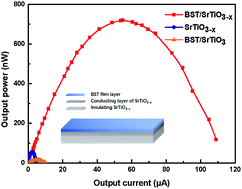Synergetic enhancement of thermoelectric performance in a Bi0.5Sb1.5Te3/SrTiO3 heterostructure†
Abstract
Thermoelectric devices enable a direct conversion between thermal energy and electrical energy. The maximum output power of thermoelectric devices is determined by  , where S is the Seebeck coefficient, ΔT is the temperature difference and Rint is the internal resistance, respectively. To achieve a high output power, a large Seebeck coefficient and a small internal resistance are required. However, the intrinsic tradeoff between the Seebeck coefficient and the electrical conductivity restrains the further improvement in single thermoelectric materials. Herein, we break this restriction by utilizing the synergetic effect in a Bi0.5Sb1.5Te3/SrTiO3 heterostructure, where the reduced SrTiO3 substrate and the Bi0.5Sb1.5Te3 overlayer contribute to a large Seebeck coefficient and a small internal resistance, respectively. As a result, the output power of the Bi0.5Sb1.5Te3/SrTiO3−x heterostructure can reach up to 722 nW (ΔT = 60 K), which is approximately a 44 and 11 times enhancement compared with the individual Bi0.5Sb1.5Te3 thin film and SrTiO3 substrate, respectively. Our studies will not only provide a general guidance to design novel thermoelectric heterostructures with enhanced performance, but also help understand the modulation doping and energy filtering effects at the atomic level.
, where S is the Seebeck coefficient, ΔT is the temperature difference and Rint is the internal resistance, respectively. To achieve a high output power, a large Seebeck coefficient and a small internal resistance are required. However, the intrinsic tradeoff between the Seebeck coefficient and the electrical conductivity restrains the further improvement in single thermoelectric materials. Herein, we break this restriction by utilizing the synergetic effect in a Bi0.5Sb1.5Te3/SrTiO3 heterostructure, where the reduced SrTiO3 substrate and the Bi0.5Sb1.5Te3 overlayer contribute to a large Seebeck coefficient and a small internal resistance, respectively. As a result, the output power of the Bi0.5Sb1.5Te3/SrTiO3−x heterostructure can reach up to 722 nW (ΔT = 60 K), which is approximately a 44 and 11 times enhancement compared with the individual Bi0.5Sb1.5Te3 thin film and SrTiO3 substrate, respectively. Our studies will not only provide a general guidance to design novel thermoelectric heterostructures with enhanced performance, but also help understand the modulation doping and energy filtering effects at the atomic level.



 Please wait while we load your content...
Please wait while we load your content...